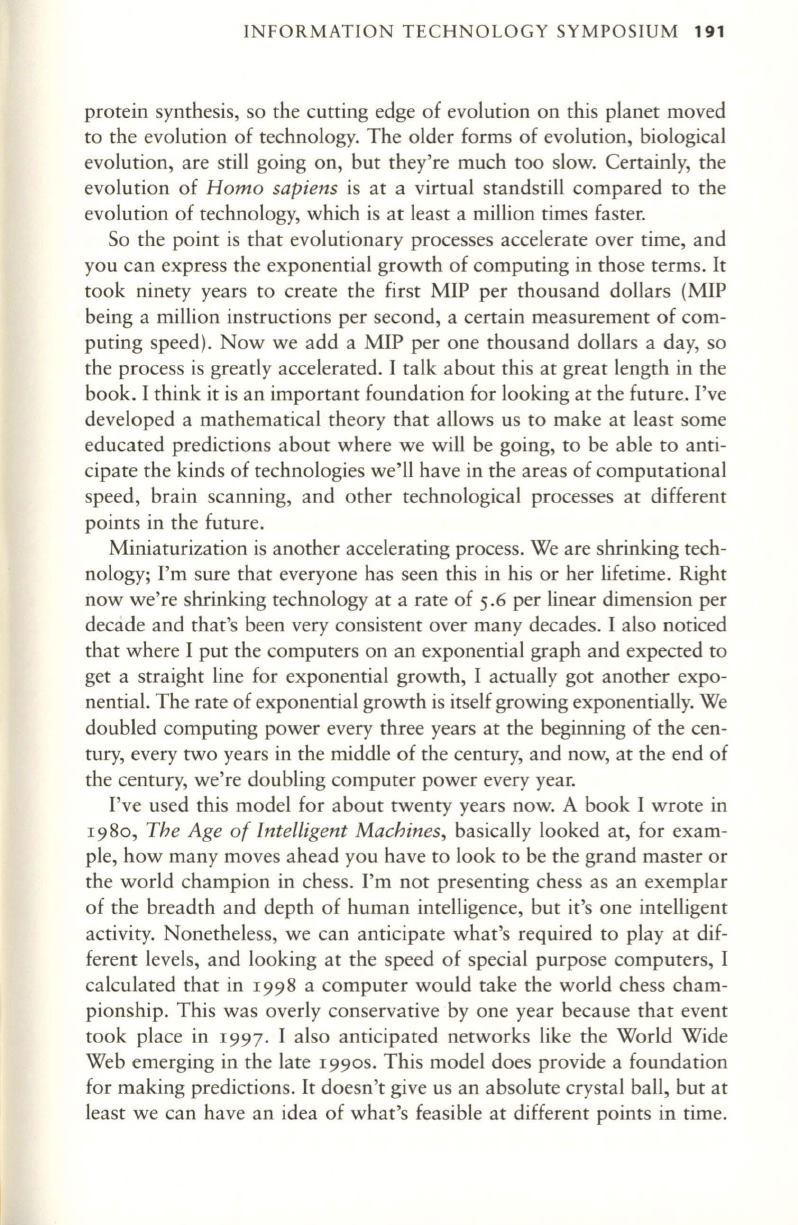
INFORMATION TECHNOLOGY SYMPOSIUM
191
protein synthesis, so the cutting edge of evolution on this planet moved
to the evolution of technology. The older forms of evolution, biological
evolution, are still going on, but they're much too slow. Certainly, the
evolution of
Homo sapiens
is at a virtual standstill compared to the
evolution of technology, which is at least a million times faster.
So the point is that evolutionary processes accelerate over time, and
you can express the exponential growth of computing in those terms.
It
took ninety years to create the first MIP per thousand dollars (MIP
being a million instructions per second, a certain measurement of com–
puting speed). Now we add a MIP per one thousand dollars a day, so
the process is greatly accelerated. I talk about this at great length in the
book. I think it is an important foundation for looking at the future. I've
developed a mathematical theory that allows us to make at least some
educated predictions about where we will be going, to be able
to
anti–
cipate the kinds of technologies we'll have in the areas of computational
speed, brain scanning, and other technological processes at different
points in the future.
Miniaturization is another accelerating process. We are shrinking tech–
nology; I'm sure that everyone has seen this in his or her lifetime. Right
now we're shrinking technology at a rate of 5.6 per linear dimension per
decade and that's been very consistent over many decades. I also noticed
that where I put the computers on an exponential graph and expected to
get a straight line for exponential growth, I actually got another expo–
nential. The rate of exponential growth is itself growing exponentially. We
doubled computing power every three years at the beginning of the cen–
tury, every two years in the middle of the century, and now, at the end of
the century, we're doubling computer power every year.
I've used this model for about twenty years now. A book I wrote in
I980,
The Age of Intelligent Machines,
basically looked at, for exam–
ple, how many moves ahead you have
to
look to be the grand master or
the world champion in chess. I'm not presenting chess as an exemplar
of the breadth and depth of human intelligence, but it's one intelligent
activity. Nonetheless, we can anticipate what's required to play at dif–
ferent levels, and looking at the speed of special purpose computers, I
calculated that in
I998
a computer would take the world chess cham–
pionship. This was overly conservative by one year because that event
took place in
I997.
I also anticipated networks like the World Wide
Web emerging in the late
I990S .
This model does provide a foundation
for making predictions.
It
doesn't give us an absolute crystal ball, but at
least we can have an idea of what's feasible at different points in time.


